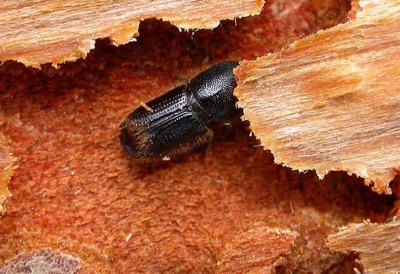Ips (or engraver) beetles are bark beetles that attack either spruce or pine trees. One of the most important ips beetle facts is that they mostly go after the dying or stressed trees, leaving the healthy ones alone. However, in widespread  infestations, all trees can be attacked. You’re more likely to see them around areas of drought, fire, or windthrow.
infestations, all trees can be attacked. You’re more likely to see them around areas of drought, fire, or windthrow.
Ips comes from part of the scientific name for the creatures, but they’re more commonly referred to as engraver beetles. Interesting ips beetle fact is that there are about 11 species of the creatures native to Colorado, attacking the various types of spruces and pines. You’ll know an Ips beetle from the red-brown/black colors and depressed cavities and spines towards their rear bodies.
Over wintered adults will remain under the bark or stay towards the base of the tree. They gain heat from the inside of the tree to survive to the next spring.
Because the beetles are so small, you’ll need to look for signs on the tree that there’s an infestation. One of the most common signs is the fading and early falling leaves. This often happens within a two month period, and can happen anytime between spring and early fall.
Unlike other types of pests, like Mountain Pine Beetles, you won’t usually see any pitch tubes, but you will see a reddish boring dust towards the tree’s base. This is where the beetles have gone in and they’re more noticeable in the warmer months. Galleries will also be created as the beetles create paths through the trees, usually in a H or Y pattern.
When the whole tree has faded, this is a sign that the beetles have already left. To manage an infestation, you will need to cut down the tree. Fresh wood from around the trees will also need to be removed to prevent any other beetles coming into the area.
To protect your valuable trees, contact SprayTech, Colorado tree spraying specialists, for a free estimate on preventive ips beetle spraying.
Comments are closed.